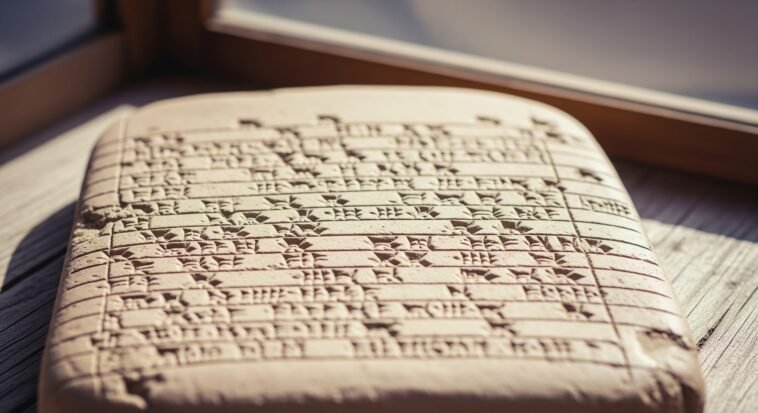
Imagine if every law, contract, or bedtime story had to be passed down like a game of telephone.
Total chaos, right? That’s why writing changed everything.
And while Egypt had some serious hieroglyph clout, the Sumerians beat them to the punch.
They were the original record-keepers—literally inventing writing (cuneiform) to track trade, taxes, and temple stuff way before Egypt carved up papyrus.
This wasn’t just doodling; it was the birth of bureaucracy, storytelling, and receipts.
The Cradle of Writing: Sumer and the Birth of Cuneiform
When did writing actually start?
Long before emojis or even alphabets, the Sumerians—living in what’s now southern Iraq—were already scribbling away around 3500 BCE.
That’s centuries before the Egyptians started carving hieroglyphs into stone (sorry, Pharaoh fans—Sumer wins the first-draft round).
Why’d they invent it?
Simple: they had receipts to keep.
The Sumerians were city-builders, temple-makers, and honestly, pretty intense record-keepers.
As their world got more complicated (think ancient spreadsheets, not poetry), they needed a better way to keep track of things like:
- Livestock and grain trades
- Taxes and who owed what
- Temple supply lists
- Legal stuff (because even 5,000 years ago, people needed contracts)
At first, they used pictographs—little drawings that said “this is a goat” or “this is three jars of beer.”
But as life got more complicated, so did their symbols.
Eventually, they created cuneiform, a wedge-shaped script that could capture sounds, ideas, and full-on drama.
It started as a practical hack, but ended up launching the written word. Total civilization upgrade.

Cuneiform: The World’s First Writing System
How did Cuneiform work?
Imagine trying to write using a chopstick and Play-Doh.
That’s basically how the Sumerians rolled.
They took a reed stylus and pressed it into soft clay, making little wedge-shaped marks (hence the name—cuneus means “wedge” in Latin, because yes, Latin had to name everything eventually).
Each symbol could mean a whole word, a sound, or even a syllable.
So it wasn’t just drawing pictures—it was a full-on language system. Super flexible, super nerdy, super effective.
Key features of Sumerian cuneiform
- Clay tablets = the ancient version of Google Drive, but with better durability
- Reed stylus = the original writing tool, no ink required
- They wrote everything: trade receipts, laws, love letters, myths—you name it
- It evolved: Started with simple pictos, then leveled up into abstract symbols that could capture full-blown poetry and political rants
A lasting legacy
Cuneiform didn’t just stay in Sumer.
It spread like the first viral trend across Mesopotamia—used by the Akkadians, Babylonians, and Assyrians.
And they didn’t just use it for receipts. We’re talking epic stories (hello, Gilgamesh), royal decrees, and ancient “DMs” between kings.
This script ran the show for over 3,000 years—longer than TikTok’s algorithm will ever last.
Egypt’s Hieroglyphs: A Parallel but Later Development
When did Hieroglyphs emerge?
Egypt finally joined the writing game around 3200–3000 BCE, a few centuries after the Sumerians were already busy logging grain shipments.
While some people think Egypt might’ve copied Mesopotamia’s homework, most historians agree: hieroglyphs were homegrown, shaped by the Nile, pyramids, and that whole “we’re gods on Earth” vibe.
Characteristics of Egyptian hieroglyphs:
- Where they wrote: Think temple walls, tombs, and scrolls—basically the ancient version of Instagram-worthy fonts carved into stone
- How they did it: Brushes for scrolls, chisels for monuments. No clay tablets here—Egypt liked its writing camera-ready.
- So many symbols: Over 700 characters—some for objects, some for sounds, some just for vibes
- What it was used for: Mostly the big stuff—religion, rituals, royal flexes. You wouldn’t find a grocery list in hieroglyphs (unless the pharaoh really wanted figs)
Comparison Table: Sumerian Cuneiform vs. Egyptian Hieroglyphs
| Feature | Sumerian Cuneiform |
Egyptian Hieroglyphs
|
| Date of Origin | ~3500 BCE |
~3200–3000 BCE
|
| Medium | Clay tablets | Stone, papyrus |
| Writing Tool | Reed stylus | Brushes, chisels |
| Structure | Logographic and phonetic |
Logographic, syllabic, ideographic
|
| Main Usage | Administration, literature, law |
Religious, monumental, ceremonial
|
| Longevity | 3,000+ years | 3,000+ years |

Why Did Writing Emerge First in Sumer?
1. Urbanization and economic complexity
Sumer wasn’t just chill farming villages—they were early urban hotspots with complex economies.
Temples and city-states managed tons of resources, and someone had to keep the score.
Enter the scribes, who basically ran the ancient “Excel sheets” tracking grain, animals, and workers.
Writing showed up because eyeballing your inventory just wouldn’t cut it anymore.
2. Technological innovation
Unlike other places scrambling for materials, Mesopotamia had clay for days.
Cheap, durable, and easy to shape—clay tablets were the perfect canvas.
Think of it as the ancient world’s reusable sticky notes, just way more official.
3. Cultural and religious drivers
Sumerians took their laws, rituals, and myths seriously.
Writing wasn’t just about business—it was about locking down stories, hymns, and history so they didn’t turn into ancient “fake news.”
This gave their culture a solid backbone and a way to flex their civilization’s legacy.
Did Egyptian Writing Derive from Sumerian Cuneiform?
Short answer: Probably not. But it’s complicated.
Both cuneiform (Sumer) and hieroglyphs (Egypt) popped up within a few centuries of each other.
So of course people ask: Did Egypt borrow the idea? Most scholars say nope—these were separate glow-ups that happened in parallel.
Why? Because the two writing systems look and function totally differently:
- Cuneiform = wedge marks in clay, built for spreadsheets and receipts
- Hieroglyphs = pretty symbols on stone and scrolls, built for tombs, gods, and drama
So yeah, the style, structure, and vibe are wildly different.
That said, some historians think there might’ve been a little “hey, cool idea” energy going on.
Like, maybe Egypt heard whispers about this new thing called “writing” and thought, “Let’s do our own version—make it pretty, though.”
Kind of like when two people invent different kinds of pizza without ever meeting, but someone somewhere had to think, “Bread + toppings = genius.”
The Impact of Sumerian Writing on Civilization
A turning point in human history
Let’s be real—when the Sumerians invented writing, they didn’t just scribble “goat = 3.” They accidentally kicked off civilization as we know it. Total game-changer.
Here’s what their writing system unlocked:
- Laws got real: No more “he said, she said.” Enter the Code of Ur-Nammu and later, Hammurabi’s Code—basically the first official “terms and conditions” of society.
- Stories lived forever: Thanks to cuneiform, we still have the Epic of Gilgamesh—one of the world’s oldest and most extra tales of gods, heroes, and existential dread.
- Cities ran smoother: Admin stuff got way easier. Imagine trying to run a city without receipts, contracts, or HR records. Cuneiform was the original back-office MVP.
- Knowledge got passed down: Instead of relying on “grandma said,” people could read actual records. Wisdom didn’t die with the storyteller anymore.
Spread and influence
Cuneiform wasn’t just a Sumer thing—it spread like the first ancient franchise model.
Everyone wanted in:
- Akkadians, Babylonians, Assyrians—they all adopted it
- It worked for multiple languages (talk about user-friendly)
- It became the diplomatic go-to—like the ancient Near East’s version of English in international meetings
So yeah, writing in Sumer wasn’t just a cool innovation—it reshaped human history, helped build empires, and gave us receipts on what people 5,000 years ago were worried about.
Spoiler: taxes, grain, and drama. Same as today.

Conclusion: Why Sumer Led the Way
So here’s the deal: the Sumerians were the first to invent writing—thanks to a perfect storm of urban growth, economic need, and a little creative tech innovation.
They weren’t just scribbling “John Doe owes 3 sheep”—they invented the whole idea of keeping records, laws, and epic stories.
Cuneiform wasn’t just writing; it was the original “unlock” of human civilization.
Sure, Egypt’s hieroglyphs came up soon after, and they had their own vibe.
But let’s be real: the Sumerians were the ones who figured out that writing could be a game-changer—from taxes to tales of gods.
And today, every book, email, and contract owes a little something to those ancient clay tablets.
Sumer didn’t just set the stage—they wrote the first lines of history.



